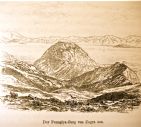
From Zugra to Akrata beach
Comparisson reports are under license of:

Lo que dice el Arxiduc:

 “To climb up Mount Panagiya, which is 750 meters tall, you climb up from the beach along a path which passes by Palaeohano Yrys, a Turkish fountain with a small LACHE [¿?] in the wall to the side […]. Approximately half-way we find the Panagiya Tis Koryphis Monastery. In olden times it was located at the top of the mountain, but the monks moved down because of the cold. The government confiscated their land, and that is why everything is abandoned now. Only an old man and his family live there today.”
“To climb up Mount Panagiya, which is 750 meters tall, you climb up from the beach along a path which passes by Palaeohano Yrys, a Turkish fountain with a small LACHE [¿?] in the wall to the side […]. Approximately half-way we find the Panagiya Tis Koryphis Monastery. In olden times it was located at the top of the mountain, but the monks moved down because of the cold. The government confiscated their land, and that is why everything is abandoned now. Only an old man and his family live there today.”
 “The town with its 55 families offers a pleasant and fairly comfortable image. It has a large paved street which heads southwest. The houses are made of stone, and many of them have doors and windows with a wooden jamb or post and rocks held by hooks above. After a climb is the Ayios Ioannis Church. It can be reached by taking a fairly steep path […]. From here is a marvelous view over the gulf with Salona in front and bald Cape Saint Nicolo sticking out. Underneath are gardens with lemon and orange trees. A lot of pomegranates, fig trees and blackberry bushes also grow there. The water from the potamos (“river”) waters the garden. The town also has fresh, precious water from a spring. Good white wine is produced in the surrounding area.”
“The town with its 55 families offers a pleasant and fairly comfortable image. It has a large paved street which heads southwest. The houses are made of stone, and many of them have doors and windows with a wooden jamb or post and rocks held by hooks above. After a climb is the Ayios Ioannis Church. It can be reached by taking a fairly steep path […]. From here is a marvelous view over the gulf with Salona in front and bald Cape Saint Nicolo sticking out. Underneath are gardens with lemon and orange trees. A lot of pomegranates, fig trees and blackberry bushes also grow there. The water from the potamos (“river”) waters the garden. The town also has fresh, precious water from a spring. Good white wine is produced in the surrounding area.”
 “Behind this point is the beach at Akrata, with a few houses on the shore. In total there are 14, some with eaves. The houses are made of stones. They are normally used to store the grapes collected during harvest because generally only six people live here.”
“Behind this point is the beach at Akrata, with a few houses on the shore. In total there are 14, some with eaves. The houses are made of stones. They are normally used to store the grapes collected during harvest because generally only six people live here.”
Datos proyecto Nixe III:
We didn’t have the chance to stop at Dervino and Akrata.















